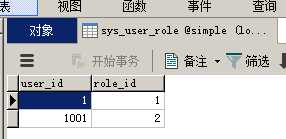标签:version 文件中 tom create sel erp data tor space
drop database if exists simple; create database simple; use simple; drop table if exists sys_user; create table sys_user ( id bigint not null auto_increment comment ‘用户ID‘, user_name varchar(50) comment ‘用户名‘, user_password varchar(50) comment ‘密码‘, user_email varchar(50) comment ‘邮箱‘, user_info text comment ‘简介‘, head_img blob comment ‘头像‘, create_time datetime comment ‘创建时间‘, primary key (id) ); alter table sys_user comment ‘用户表‘; drop table if exists sys_role; create table sys_role( id bigint not null auto_increment comment ‘角色ID‘, role_name varchar(50) comment ‘角色名‘, enabled int comment ‘有效标志‘, create_by bigint comment ‘创建人‘, create_time datetime comment ‘创建时间‘, primary key (id) ); alter table sys_role comment ‘角色表‘; drop table if exists sys_privilege; create table sys_privilege ( id bigint not null auto_increment comment ‘权限ID‘, privilege_name varchar(50) comment ‘权限名称‘, privilege_url varchar(50) comment ‘权限URL‘, primary key (id) ); alter table sys_privilege comment ‘权限表‘; drop table if exists sys_user_role; create table sys_user_role ( user_id bigint comment ‘用户ID‘, role_id bigint comment ‘角色ID‘ ); alter table sys_user_role comment ‘用户角色关联表‘; drop table if exists sys_role_privilege; create table sys_role_privilege ( role_id bigint comment ‘用户ID‘, privilege_id bigint comment ‘角色ID‘ ); alter table sys_role_privilege comment ‘角色权限关联表‘;



假如1个用户只能有1种角色sys_user和sys_role是通过sys_user_role一对一关联;
1.使用自动映射处理一对一关系;优点:当一定会使用到嵌套结果时使用。
1.在SysUser.class model中增加SysRole的对象。
private SysRole role;
2.在查询的xml Mapper文件中对查询出的role属性写出对应的属性名称。
<select id="selectUserAndById" resultType="test.model.SysUser"> select u.id, u.user_name userName, u.user_password userPassword, u.user_email userEmail, u.create_time createTime, u.user_info userInfo, u.head_img headImg, r.id "role.id", r.role_name "role.roleName", r.enabled "role.enabled", r.create_by "role.createBy", r.create_time "role.createTime" from sys_user u inner join sys_user_role ur on u.id=ur.user_id inner join sys_role r on ur.user_id=r.id where u.id=#{id} </select>
2.使用resultMap配置一对一映射
<?xml version="1.0" encoding="UTF-8"?> <!DOCTYPE mapper PUBLIC "-//mybatis.org//DTD Mapper 3.0//EN" "http://mybatis.org/dtd/mybatis-3-mapper.dtd"> <mapper namespace="test.dao.SysUserMapper"> <resultMap id="BaseResultMap" type="test.model.SysUser"> <!-- WARNING - @mbggenerated This element is automatically generated by MyBatis Generator, do not modify. --> <id column="id" jdbcType="BIGINT" property="id" /> <result column="user_name" jdbcType="VARCHAR" property="userName" /> <result column="user_password" jdbcType="VARCHAR" property="userPassword" /> <result column="user_email" jdbcType="VARCHAR" property="userEmail" /> <result column="create_time" jdbcType="TIMESTAMP" property="createTime" /> <result column="user_info" jdbcType="LONGVARCHAR" property="userInfo" /> <result column="head_img" jdbcType="LONGVARBINARY" property="headImg" /> </resultMap> <resultMap type="test.model.SysUser" id="userRoleResultMap" extends="BaseResultMap"> <!-- role相关属性 --> <result column="role_id" jdbcType="BIGINT" property="role.id" /> <result column="role_name" jdbcType="VARCHAR" property="role.roleName" /> <result column="enabled" jdbcType="INTEGER" property="role.enabled" /> <result column="create_by" jdbcType="BIGINT" property="role.createBy" /> <result column="role_create_time" jdbcType="TIMESTAMP" property="role.createTime" /> </resultMap>
<!-- 注意返回 resultMap="userRoleResultMap"--> <select id="selectUserAndById" resultMap="userRoleResultMap"> select u.id, u.user_name userName, u.user_password userPassword, u.user_email userEmail, u.create_time createTime, u.user_info userInfo, u.head_img headImg, r.id role_id, r.role_name role_name, r.enabled enabled, r.create_by create_by, r.create_time role_create_time from sys_user u inner join sys_user_role ur on u.id=ur.user_id inner join sys_role r on ur.user_id=r.id where u.id=#{id} </select> </mapper>
3.使用resultMap的associaction标签配置一对一映射
<?xml version="1.0" encoding="UTF-8"?> <!DOCTYPE mapper PUBLIC "-//mybatis.org//DTD Mapper 3.0//EN" "http://mybatis.org/dtd/mybatis-3-mapper.dtd"> <mapper namespace="test.dao.SysUserMapper"> <resultMap id="BaseResultMap" type="test.model.SysUser"> <!-- WARNING - @mbggenerated This element is automatically generated by MyBatis Generator, do not modify. --> <id column="id" jdbcType="BIGINT" property="id" /> <result column="user_name" jdbcType="VARCHAR" property="userName" /> <result column="user_password" jdbcType="VARCHAR" property="userPassword" /> <result column="user_email" jdbcType="VARCHAR" property="userEmail" /> <result column="create_time" jdbcType="TIMESTAMP" property="createTime" /> <result column="user_info" jdbcType="LONGVARCHAR" property="userInfo" /> <result column="head_img" jdbcType="LONGVARBINARY" property="headImg" /> </resultMap> <!-- 继承上面的UserResultMap --> <resultMap type="test.model.SysUser" id="userRoleResultMap" extends="BaseResultMap"> <!-- role相关属性 --> <!-- 对应的ResultMap在test.dao.SysRoleMapper这个命名控件中--> <association property="role" columnPrefix="role_" resultMap="test.dao.SysRoleMapper.BaseResultMap"></association> </resultMap> <select id="selectUserAndById" resultMap="userRoleResultMap"> select u.id, u.user_name userName, u.user_password userPassword, u.user_email userEmail, u.create_time createTime, u.user_info userInfo, u.head_img headImg, r.id role_id, r.role_name role_role_name, r.enabled role_enabled, r.create_by role_create_by, r.create_time role_create_time from sys_user u inner join sys_user_role ur on u.id=ur.user_id inner join sys_role r on ur.user_id=r.id where u.id=#{id} </select> <mapper/>
<mapper namespace="test.dao.SysRoleMapper"> <resultMap id="BaseResultMap" type="test.model.SysRole"> <!-- WARNING - @mbggenerated This element is automatically generated by MyBatis Generator, do not modify. --> <id column="id" jdbcType="BIGINT" property="id" /> <result column="role_name" jdbcType="VARCHAR" property="roleName" /> <result column="enabled" jdbcType="INTEGER" property="enabled" /> <result column="create_by" jdbcType="BIGINT" property="createBy" /> <result column="create_time" jdbcType="TIMESTAMP" property="createTime" /> </resultMap> </mapper>
4.association标签的嵌套查询 (子查询)
标签:version 文件中 tom create sel erp data tor space
原文地址:http://www.cnblogs.com/watermelonban/p/7597988.html